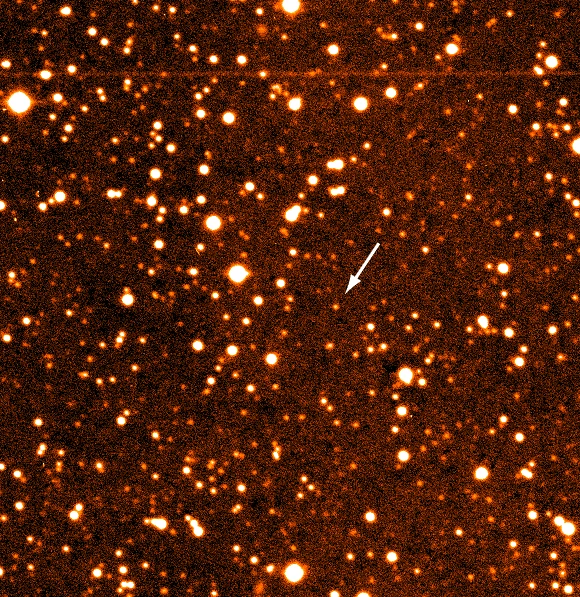
Quaoar, officially designated (50000) Quaoar, is a dwarf planet located in the Kuiper Belt. Discovered in 2002 by astronomers Chad Trujillo and Michael Brown, it orbits the Sun at an average distance of \(43.7\) astronomical units (AU). With a diameter of about \(1110\) km, Quaoar is one of the largest known trans-Neptunian objects.
| Object | Diameter (km) | Semi-major axis (AU) | Features |
|---|---|---|---|
| Pluto | 2376 ± 3 | 39.48 | Five moons including Charon (mass ratio 1:8, binary system), tenuous nitrogen–methane atmosphere in sublimation-condensation equilibrium, probable cryovolcanism, differentiated interior (rocky core, water-ice mantle). |
| Eris | 2326 ± 12 | 67.78 | Record albedo 0.96 (very reflective surface rich in nitrogen and frozen methane), moon Dysnomia, high density ≈ 2.5 g/cm³ indicating a dominant rocky core, highly eccentric orbit (e = 0.44). |
| Haumea | 1560 × 1012 × 852 | 43.13 | Ultra-fast rotation in 3.9 h causing extreme flattening (triaxial ellipsoid), two moons Namaka and Hi‘iaka, narrow ring detected in 2017, surface covered with crystalline water ice, albedo ≈ 0.7. |
| Makemake | 1430 ± 9 | 45.79 | Surface dominated by solid methane with ethane and red tholins, almost no atmosphere (pressure < 10⁻⁴ Pa), moon S/2015 (136472) 1 discovered in 2016, density ≈ 1.7 g/cm³. |
| Gonggong | 1230 ± 50 | 67.38 | Slow rotation (22.4 h) suggesting partial tidal locking with its moon Xiangliu (diameter 100–300 km, uncertain). Dark red surface rich in complex organic compounds. The name refers to the Chinese water deity Gonggong, symbol of chaos and floods, and his nine-headed serpent servant Xiangliu (相柳). |
| Quaoar | 1110 ± 5 | 43.69 | Ring system located at 7.4 planetary radii (beyond Roche limit), moon Weywot, density ≈ 1.99 g/cm³, surface mixing water ice, methanol, and silicates. Likely retained internal heat allowing past cryovolcanic activity. |
| Sedna | 995 ± 80 | 506 | Object of the inner Oort Cloud, extremely elongated orbit (e = 0.85) with perihelion at 76 AU and aphelion ≈ 937 AU, orbital period ≈ 11,400 years, reddish surface rich in tholins and frozen methane. Possibly shaped by a passing star or a hypothetical ninth planet. |
| Ceres | 940 × 932 × 852 | 2.77 | Differentiated body with crust rich in carbonates and water ice, active cryovolcanism (Ahuna Mons), bright spots of sodium carbonates revealed by the Dawn mission, possible subsurface salty ocean, surface gravity ≈ 0.27 m/s². |
| Orcus | 910 ± 25 | 39.40 | Moon Vanth (diameter ≈ 440 km) forming a binary system, 2:3 resonance with Neptune like Pluto, surface containing water ice and methane, density ≈ 1.6 g/cm³. Often described as Pluto’s “inverted twin” (mirror orbital configuration). |
In 2023, an international team announced the surprising discovery of a ring system around Quaoar. These rings are located at a distance of \(4057\) km from the center of the dwarf planet, well beyond the Roche limit, where tidal forces should prevent the formation of such structures. This discovery challenges our current models of ring formation and stability.
Several hypotheses are put forward to explain the formation of Quaoar's rings:
The recently discovered rings around the dwarf planet Quaoar pose a physical challenge related to their formation, composition, and stability. Their existence relies on a complex dynamic balance between Quaoar's gravity, tidal forces (notably the Roche limit), and interactions between particles.
Several hypotheses explain their origin: debris from collisions, disintegration of a nearby satellite, or accumulation of dust. The stability of the system depends on internal collisions, gravitational resonances with potential small shepherd satellites, and non-gravitational effects such as solar radiation pressure.
The particles making up these rings are mainly composed of water ice and organic materials, with sizes ranging from microns to centimeters.